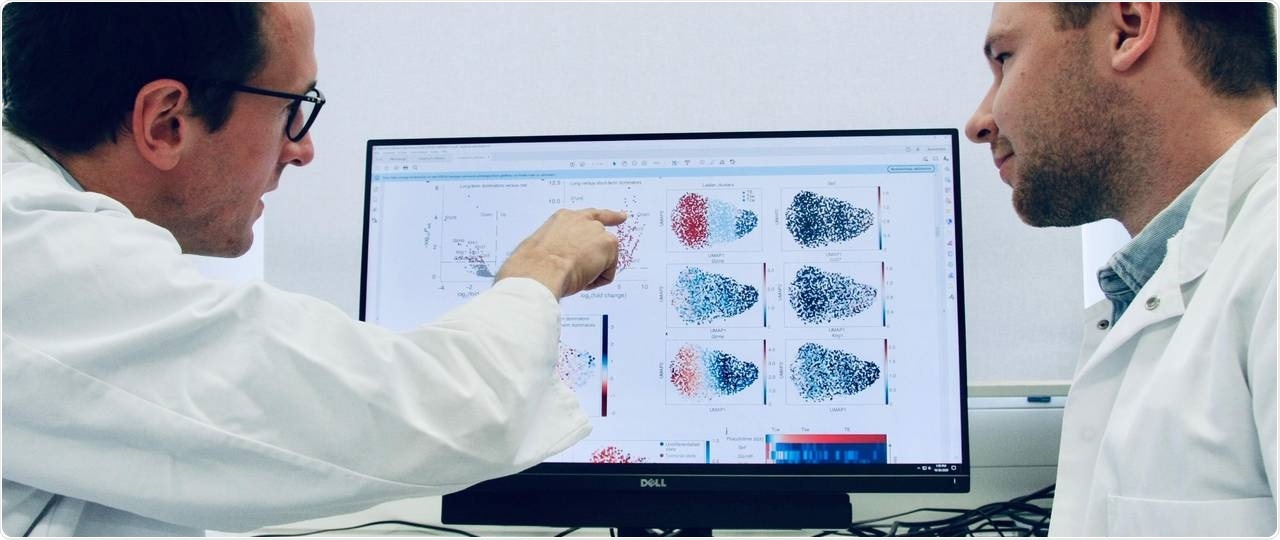A person will acquire immunity to a specific disease when T cells develop into memory cells after making contact with pathogens.

Research group leader Dr Veit Buchholz (left) and first author Lorenz Mihatsch from the Institute for Medical Microbiology, Immunology and Hygiene. Image Credit: Susanne Dürr/Technical University of Munich.
To date, the number of cells that perform this activity was assumed to rely mainly on the level of the initial immune response. Now, a research team from the Technical University of Munich (TUM) has challenged this concept.
As soon as a virus enters the body, it is detected by particular cells of the immune system. These cells carry the pathogen to the lymph nodes, wherein they present its fragments, called antigens, to CD8+ T cells that are responsible for controlling viral infections.
All these cells transport a special T cell receptor on the surface that can identify certain antigens, but only a scant number of T cell receptors match the antigen of a given virus.
To increase the defenses against the virus and bring the infection under control, these few antigen-specific T cells begin to divide quickly and grow into effector T cells. They destroy virus-infected host cells and subsequently die off themselves as soon as the infection is eliminated.
According to the generally accepted theory, a few of these short-lived effector cells develop into memory T cells, which continue to exist in the virus long term. In case the same virus penetrates the body again, the memory T cells already exist and are ready to combat the pathogen more quickly and effectively than during the initial encounter.
Memory cells and their origin
Prevailing scientific opinion says that activated T cells first become effector cells and only then gradually develop into memory cells. In our view, however, that isn't the case. It would mean that the more effector cells are formed after contact with the pathogen, the more numerous the memory cells would become.”
Dr Veit Buchholz, Specialist in Microbiology, Technical University of Munich
Buchholz is also the working group leader at the Institute for Medical Microbiology, Immunology and Hygiene at TUM.
But Buchholz and his collaborators noted a different course of events and have recently reported their results in the Nature Immunology journal.
We investigated the antiviral immune responses resulting from individual activated T cells in mice and traced the lineage of the ensuing memory cells using single-cell fate mapping. Based on these experiments, we were able to show that certain 'T cell families' descended from individual cells form up to 1000 times more 'memory' than others.
Dr Simon Grassmann, Study First Author, Technical University of Munich
Dr Grassmann continued, “However, these long-term dominating T cell families only contributed little to the magnitude of the initial immune response, which was dominated by effector cells derived from other shorter-lived T cell families.”
At the magnitude of individual cells, it thus became evident that the formation of memory and effector cells separates at a relatively earlier phase than believed before.
Already in the first week after the confrontation with the pathogen, we saw major differences in the transcriptomes of the detected T cell families.”
Lorenz Mihatsch, Study First Author, Technical University of Munich
Mihatsch continued, “Normally at this time of the immune response CD8+ T cells are enriched in molecules that help to kill virus-infected cells. However, we found no indication of these cytolytic molecules in the long-term dominating T cell families. Instead, they were already geared exclusively towards memory development at this early stage.”
Optimization of vaccines
According to Dr Buchholz, these outcomes may help enhance the development of vaccines in the day to come. “To generate an optimal immune response through vaccination, the body needs to produce as many memory cells as possible. For that purpose, it is important to have a precise understanding of how individual T cells are programmed,” Dr Buchholz added.
The study conducted by Dr Buchholz may also prove useful in identifying whether a novel vaccine is effective or not relatively sooner.
“To determine the long-term strength of an immune response, it could be helpful to measure the number of memory precursors within a few days of administering a vaccine,” Dr Buchholz concluded.
Source:
Journal reference:
Grassmann, S., et al. (2020) View Early emergence of T central memory precursors programs clonal dominance during chronic viral infection. Nature Immunology. doi.org/10.1038/s41590-020-00807-y.